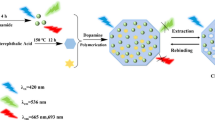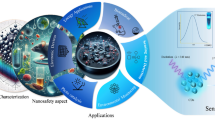Abstract
The electrocatalytic activity of metal-organic framework (MOF)-derived NiO@ZnO hollow microspheres was studied for its application to an isoniazid sensor. The MOF-derived NiO@ZnO hollow spheres were synthesized by the coordination reaction of terephthalic acid with Zn2+ and Ni2+ and followed by calcination. Morphology characterization showed that the MOF-derived NiO@ZnO sphere has circular core-shell structure with pores on its surface. Further electrochemical characterization of the prepared sensor by cyclic voltammetry and differential pulse voltammetry proved that the material has good electrical conductivity and strong catalytic ability. Distinct oxidation peaks occur for INZ at potential of 0.22 V (vs. saturated calomel electrode). Under the optimal experimental conditions, the linear range of the sensor for isoniazid determination was 0.8 ~ 800 μM, and the detection limit was 0.25 μM (S/N = 3). In addition, the sensor displayed good stability, repeatability, and reproducibility. The established method was successfully applied for determination of isoniazid in tablets and mouse serum with admirable accuracy and reliability.

Schematic presentation of an electrochemical sensor based on MOF-derived NiO@ZnO hollow microspheres for isoniazid determination.




Similar content being viewed by others
References
Goldkind L, Laine L (2010) A systematic review of NSAIDs withdrawn from the market due to hepatotoxicity: lessons learned from the bromfenac experience. Pharmacoepidemiol Drug Saf 15(4):213–220
Epstein MM, Nelson SD, Slattery JT, Kalhorn TF, Wall RA, Wright JM (2012) Inhibition of the metabolism of paracetamol by isoniazid. Br J Clin Pharmacol 31(2):139–142
Dan D, González-Peralta RP, Mcclenathan DT, Wilsey MJ, Haafiz A (2011) Isoniazid-induced severe hepatotoxicity: an infrequent but preventable cause of liver failure in children treated for latent tuberculosis infection. Clin Med Insights Pediatr 5(5):9–13
Iranifam M, Khodaei S, Saadati M (2019) Chemiluminescence reaction of graphene oxide-luminol-dissolved oxygen and its application for determination of isoniazid and paracetamol. Microchem J 146:850–855
Tilinca M, Hancu G, Mircia E, Iriminescu D, Rusu A, Vlad RA, Barabas E (2017) Simultaneous determination of isoniazid and rifampicin by UV spectrophotometry. Farmacia 65(2):219–224
Mahjoub AA, Khan AH, Sulaiman SAS, Lajis R, Man CN, Ali IAH (2016) Simultaneous determination of isoniazid and pyrazinamide in plasma by high performance liquid chromatography. Trop J Pharm Res 15(11):2475–2481
Lodico CP, Levine BS, Goldberger BA, Caplan YH (1992) Distribution of isoniazid in an overdose death. J Anal Toxicol 16(16):57–59
Couto RAS, Lima JLFC, Quinaz MB (2015) Screen-printed electrode based electrochemical sensor for the detection of isoniazid in pharmaceutical formulations and biological fluids. Int J Electrochem Sci 10:8738–8749
Kan T, Qiang M, Jing L, Sheng X, Ye Z, Wei W, Xiaoya L, Yao G (2018) Water-dispersible molecularly imprinted nanohybrids via co-assembly of carbon nanotubes with amphiphilic copolymer and photocrosslinking for highly sensitive and selective paracetamol detection. Biosens Bioelectron 117:713–719
Scior T, Garcés-Eisele SJ (2006) Isoniazid is not a lead compound for its pyridyl ring derivatives, isonicotinoyl amides, hydrazides, and hydrazones: a critical review. Curr Med Chem 13(18):2205–2219
Zhuo G, Wang ZY, Wang HH, Huang GQ, Li MM (2015) Electrochemical sensor for isoniazid based on the glassy carbon electrode modified with reduced graphene oxide–au nanomaterials. Mater Sci Eng C 57:197–204
Spindola FR, Zanin H, Macena SC, André C, Rita de Cássia SL, Damos FS (2017) Evaluation of a novel composite based on functionalized multi-walled carbon nanotube and iron phthalocyanine for electroanalytical determination of isoniazid. J Solid State Electrochem 21(4):1089–1099
Bergamini MF, Santos DP, Zanoni MVB (2010) Determination of isoniazid in human urine using screen-printed carbon electrode modified with poly-L-histidine. Bioelectrochemistry 77(2):133–138
Cheemalapati S, Chen SM, Ali MA, Al-Hemaid FMA (2014) Enhanced electrocatalytic oxidation of isoniazid at electrochemically modified rhodium electrode for biological and pharmaceutical analysis. Colloids Surf B Biointerfaces 121(9):444–450
Azad UP, Prajapati N, Ganesan V (2015) Selective determination of isoniazid using bentonite clay modified electrodes. Bioelectrochemistry 101:120–125
Zhang Y, Wang Y, Jia J, Wang J (2012) Nonenzymatic glucose sensor based on graphene oxide and electrospun NiO nanofibers. Sensors Actuators B Chem 171-172(9):580–587
Zhang Y, Wang Y, Xie YL, Cheng T, Huang W (2014) Porous hollow Co3O4 with rhombic dodecahedral structures for high-performance supercapacitors. Nanoscale 6(23):14354–14359
Yan ZT, Gong YJ, Chen BH, Wu XN, Liu Q, Cui LL, Xiong SS, Peng SM (2020) Methyl functionalized Zr-Fum MOF with enhanced xenon adsorption and separation. Sep Purif Technol 239:116514
Li SN, Zhang LY, Liang X, Wang TT, Chen XJ, Liu CM, Li L, Wang CG (2019) Tailored synthesis of hollow MOF/polydopamine Janus nanoparticles for synergistic multi-drug chemo-photothermal therapy. Chem Eng J 378:122175
Wang L, Chen Y (2020) Luminescence-sensing Tb-MOF nanozyme for the detection and degradation of estrogen endocrine disruptors. ACS Appl Mater Interfaces 12(7):8351–8358
Zhang Z, Huang Y, Gao H, Hang JX, Li C, Liu PB (2020) MOF-derived ionic conductor enhancing polymer electrolytes with superior electrochemical performances for all solid lithium metal batteries. J Membr Sci 598:117800
Lee G, Cheng Y, Varanasi CV, Jie L (2014) Influence of the nickel oxide nanostructure morphology on the effectiveness of reduced graphene oxide coating in supercapacitor electrodes. J Phys Chem C 118(118):2281–2286
Hao N, Dan Z, Xue Y, Xin L, Qian W, Qu F (2015) Towards three-dimensional hierarchical ZnO nanofiber@Ni (OH)2 nanoflake core-shell heterostructures for high-performance asymmetric supercapacitors. J Mater Chem A 3(36):18413–18421
Li N, Wang JY, Liu ZQ, Guo YP, Wang DY, Su YZ, Chen S (2014) One-dimensional ZnO/Mn3O4 core/shell nanorod and nanotube arrays with high supercapacitive performance for electrochemical energy storage. RSC Adv 4(33):17274–17281
Li JH, Kuang DZ, Feng YL, Zhang FX, Xu ZF, Liu MQ, Wang DP (2013) Electrochemical tyrosine sensor based on a glassy carbon electrode modified with a nanohybrid made from graphene oxide and multiwalled carbon nanotubes. Microchim Acta 180:49–58
Jin J, Tomokazu I, Cao CS, Song YL, Jiang L, Li TJ, Zhu DB (2001) Self-assembly of uniform spherical aggregates of magnetic nanoparticles through π-π interactions. Angew Chem Int Ed 40(11):2135–2138
Yang J, Jian P, Chen DH, Yan CS, Hu YY, Zhang Q, Chen G (2017) Mixed-metallic MOF based electrode materials for high performance hybrid supercapacitors. J Mater Chem A 5:1094–1102
Li GC, Liu PF, Liu R, Liu MM, Tao K, Zhu SR, Wu MK, Yi F, Han L (2016) MOF-derived hierarchical double-shelled NiO/ZnO hollow spheres for high-performance supercapacitor. Dalton Trans 45(34):13311–13316
Huang B, Jie L, Lai L, Feng Y, Xue Y, Ye BC, Li Y (2017) A free-standing electrochemical sensor based on graphene foam-carbon nanotube composite coupled with gold nanoparticles and its sensing application for electrochemical determination of dopamine and uric acid. J Electroanal Chem 801:129–134
Kokulnathan T, Suvina V, Wang TJ, Balakrishna RG (2019) Synergistic design of a tin phosphate-entrapped graphene flake nanocomposite as an efficient catalyst for electrochemical determination of the antituberculosis drug isoniazid in biological samples. Inorg Chem Front 6:1831–1841
San X, Li M, Liu D, Wang G, Shen Y, Meng D, Meng F (2018) A facile one-step hydrothermal synthesis of NiO/ZnO heterojunction microflowers for the enhanced formaldehyde sensing properties. J Alloys Compd 739:260–269
Majidi MR, Jouyban A, Asadpour-Zeynali K (2006) Voltammetric behavior and determination of isoniazid in pharmaceuticals by using overoxidized polypyrrole glassy carbon modified electrode. J Electroanal Chem 589(1):32–37
Li Y, Liu Y, Yang Y, Yu F, Liu J, Song H, Liu J, Tang H, Ye BC, Sun Z (2015) Novel electrochemical sensing platform based on a molecularly imprinted polymer decorated 3D nanoporous nickel skeleton for ultrasensitive and selective determination of metronidazole. ACS Appl Mater Interfaces 7(28):15474–15480
Funding
This work was financially supported by Shenzhen Science and Technology Program (KQTD20170810105439418), the Innovative team and talent training project of Shihezi (2018TD02), Innovation and entrepreneurship project for overseas high-level talents of Shenzhen (KQJSCX20180328165437711) and National Natural Science Foundation of China (81773680).
Author information
Authors and Affiliations
Corresponding authors
Ethics declarations
Conflict of interest
The author(s) declare that they have no competing interests.
Additional information
Publisher’s note
Springer Nature remains neutral with regard to jurisdictional claims in published maps and institutional affiliations.
Electronic supplementary material
ESM 1
Supplementary data associated with this article can be found in the online version at ***. (DOCX 2670 kb).
Rights and permissions
About this article
Cite this article
Wang, J., Zhao, J., Yang, J. et al. An electrochemical sensor based on MOF-derived NiO@ZnO hollow microspheres for isoniazid determination. Microchim Acta 187, 380 (2020). https://doi.org/10.1007/s00604-020-04305-8
Received:
Accepted:
Published:
DOI: https://doi.org/10.1007/s00604-020-04305-8




